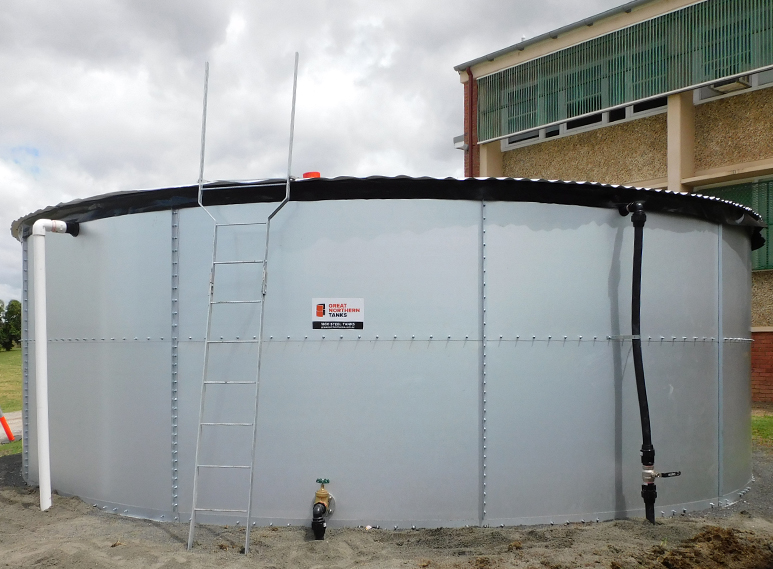

Call Us Now
1800 STEEL TANKS
Request a call back
Quick Quote
"*" indicates required fields


"*" indicates required fields
Water security has become a great concern across Australia, because of inadequate dams, overpopulation, and the effects of global warming, culminating in frequent catastrophic droughts.
Great Northern Tanks is dedicated to assisting our customers with any water concerns, for them to live a life without any water worries. Our goal is to provide a complete solution for any bulk water storage needs, including supply and installation, while also ensuring that there are no chemical pollutants, and that the system meets Australian Drinking Water Guidelines and Standards.
Many businesses and the products they offer wouldn’t survive without water. Water is used in almost every step of the manufacturing and industrial processes all over the world. Water is important and is essential in every item manufactured in the world, whether it’s deionized water, water for electronics and pharmaceuticals or softened water for boiler feed applications.
Deionized water, for example, is a necessary component in medical, electronics, and food processing. Ultra-pure water (EUP) is water that has practically all minerals, dissolved gases, and dirt particles removed, which could otherwise interfere with the production of precise and sensitive items like circuit boards.
Meanwhile, feed water is utilised in boilers and cooling towers to maximise boiler and system life, lower maintenance costs, and maintain operational performance.
The technologies chosen and the order in which they occur in each industrial water tank treatment system varies depending on the contaminants to be distinguished, but you can limit down what you might see in these four popular industrial water supply treatment systems. The following is a list of what a typical industrial water supply treatment system should include:
In semiconductor manufacturing, distilled water is being used.
Water is a necessary component in the production of semiconductors and chips, which are used in computers, cell phones, and automobiles on a regular basis. It also eliminates contaminants from silicon wafers. For example, a single 8” wafer, which can support up to 100 chips, it could require up to 2,000 litres of UPW.
To remove heat from processes or equipment, cooling systems are used. Heat is transmitted from one medium to another medium, or process fluid, which is usually water. Temperature affects many of the features of water, including the behaviour of the toxins it contains. As a result, water temperature has an impact on a system’s ability to corrode, scale, or promote microbiological development.
The oil and gas industry is responsible for less than 5% of total withdrawals globally, but it plays a significant role in protecting water quality in the areas where industrial water tanks operate. From extraction to refineries and petrochemicals, water is a raw resource that is used and generated in large amounts in the oil industry. Injection water, production water, process water, wastewater, rainwater, cooling water, tank cleaning water, and other applications are just a few examples.
Even though digitization has led to a shift away from printed products, the pulp and paper industry continues to be one of the greatest users of industrial water tanks. It is involved in 85 percent of all three stages of paper manufacture, namely pulp generation, pulp processing, and paper/paper board production, as well as the related activities of cooking, bleaching, and washing. The pulp and paper industry consumes a considerable amount of water that is solely used for processing, resulting in large volumes of contaminated wastewater.
Our health is being jeopardised by water contamination. Each year, hazardous water kills more people than all other forms of violence combined. To be frank, our sources of water supply are limited: We only have access to less than 1% of the world’s freshwater supply. If we do not do anything to prevent climate change, the problems will only get worse by 2050, when global freshwater demand is estimated to be one-third more than it is currently. If we continue with corrupting our freshwater with dangerous chemicals or microorganisms, and/ or waste by contaminating our streams, rivers, lakes, wetlands, oceans, or any other body of water, we are in deep water troubles.
An industrial water tank treatment system purifies water to make it more suitable for a specific use, such as consumption, manufacturing, or disposal. However, each system will vary based on the demands of the facility, and many of the technologies that make up these systems are the same.
The technologies chosen and the sequence in which they occur in each water treatment system varies depending on the contaminants to be treated.
The following are examples of common industrial water tank treatments:
Any unprocessed water that occurs naturally in the environment, such as rainwater, groundwater, and lakes are considered as raw water. Raw water can be used for rinsing, product formulations, and even human consumption in industrial settings if it is thoroughly cleansed. Raw water treatment is mainly focused on protecting downstream equipment against pollutants in the source water that cause fouling, corrosion, and other forms of harm or premature wear. During raw water treatment, suspended/colloidal particles, iron, bacteria, and hardness are typically removed.
A wastewater industrial water supply treatment system will help the business avoid any harm to the environment and human health. As well as the equipment, operations, or products of the business. It will also assist the facility in avoiding large fines and even legal action if wastewater is discharged unlawfully to the environment or publicly owned treatment plants. The complexity of a wastewater treatment system is mostly determined by the compliance standards that apply to your facility and the makeup of your waste stream.
Cooling industrial water tank treatments are guarded by cooling water treatment systems from pollutants in feed water, circulation water, and/or blowdown water.
Chlorides, hardness, iron, biological materials, silica, sulphates, TDS, and/or TSS are examples of pollutants. Scaling, corrosion, biological development, and fouling of cooling tower equipment can occur due to untreated cooling feed water, resulting in costly plant downtime, lower productivity, and high maintenance or equipment replacement costs over time.
Industrial water supply quality requirements vary for its use, area, and local administration. Water required for food and beverage processing, for example, is different from water required for oil and gas extraction and treatment.
Each grade of pure water is utilised for a variety of purposes, including:
● Deionized water – Boiler feed at medium pressure, renal dialysis make-up, and battery top-up.
● Purified water – Pharmaceuticals, cosmetics, and chemical manufacture.
● Pyrogenic water – Used for vial washing, tissue culture, and injection water.
● High-purity water – Used in high-pressure boilers, CHP systems, and laboratories.
● Ultrapure water – Used in microelectronics and supercritical boilers.
Water is a natural valuable resource. Us humans from all over the world depend on potable water for our thirst and health. However, it’s also a key source of infection. Waste generated by manufacturing or industrial companies is referred to as industrial waste. The effects of these can cause the plants and animals nutrition to deteriorate, and this can cause the health of humans to deteriorate as well. Sea weeds, molluscs, marine birds, fish, crustaceans, and other sea animals that provide food for humans are being killed by contaminants in the water.
Chemicals, dirt, gravel, solvents, and scrap lumbers are just a few examples of industrial waste. Hazardous and non-hazardous waste are separated from industrial solid waste, which might be solid, liquid, or gas in containers. Hazardous waste can be produced by manufacturing and other industrial activities. Hazardous waste also includes certain commercial items such as cleaning fluids, paints, and insecticides that are disposed of by businesses or individuals.
Freshwater is used by many industrial facilities to transport waste from the plant to rivers, lakes, and oceans.
Industrial pollutants include the following:
● Asbestos – This contaminant is carcinogenic and poses a major health risk. Asbestos fibres can cause diseases such asbestosis, mesothelioma, lung cancer, intestinal cancer, and liver cancer when simply inhaled.
● Lead – A metallic element that can harm public health and the environment. Because it is a non-biodegradable chemical, it’s difficult to clean up once it has contaminated the environment. Many species, including humans, are poisoned by lead because it inhibits the action of physiological enzymes.
● Sulphur – A non-metallic compound that is toxic to marine life.
● Oil – Oil does not dissolve in water and instead forms a thick coating on top of the water surface. This may prevent aquatic plants from obtaining sufficient light for photosynthesis. Fish and seabirds are also at risk.
● Petrochemicals – Hazardous to marine life and are made from gas or petrol.
● Mercury – An element that can harm human health and the environment. Because it’s a non-biodegradable chemical, it’s difficult to clean up once it’s contaminated the environment. Mercury toxicity can also affect animals.
● Nitrates and Phosphates – Both elements have the same effect on water pollution. When the use of fertiliser increases, nitrates are frequently washed off from the soil and are later transmitted into rivers and lakes. This can lead to eutrophication, which is dangerous to marine habitats.
How can we resolve this global issue? In an industrial setting, there are multiple strategies to reduce harmful industrial water supply waste. Any source reduction and/or recycling activity conducted by a waste generator is included in waste minimization (companies that generate waste/garbage with its operations). These efforts result in a decrease in waste produced and/or a decrease in waste toxicity.
You can follow these methods:
● Change the product’s composition to lessen the quantity of waste generated during its use.
● Reduce or eliminate the use of hazardous materials in the manufacturing process.
● Change the production process, equipment, layout, pipes, or operating conditions using technology (including measuring and cutting).
● Purchase only what is needed to prevent wasting materials.

Toowoomba
66 Carrington Rd
Torrington QLD 4350
Phone: 07 4566 2900
Livingstone
2658 Stuart Highway
Livingstone NT 0822
"*" indicates required fields